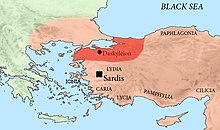Hellespontine Phrygia
| Hellespontine Phrygia | |||||||
|---|---|---|---|---|---|---|---|
| Satrapy of the Persian Empire | |||||||
| 525 BC–321 BC | |||||||
 The location of Hellespontine Phrygia, and the provincial capital of Dascylium, in the Achaemenid Empire, c. 500 BC. | |||||||
| Capital | Dascylium | ||||||
| History | |||||||
• Established | 525 BC | ||||||
• Disestablished | 321 BC | ||||||
| |||||||

Hellespontine Phrygia (Ancient Greek: Ἑλλησποντιακὴ Φρυγία, romanized: Hellēspontiakē Phrygia) or Lesser Phrygia (Ancient Greek: μικρᾶ Φρυγία, romanized: mikra Phrygia) was a Persian satrapy (province) in northwestern Anatolia, directly southeast of the Hellespont.[1] Its capital was Dascylium, and for most of its existence it was ruled by the hereditary Persian Pharnacid dynasty.[2] Together with Greater Phrygia, it made up the administrative provinces of the wider Phrygia region.[3]
History[]

The satrapy was created in the beginning of the fifth century BC, during the time of administrative reorganisations of the territories in western Asia Minor,[4] which were amongst the most important Achaemenid territories.
The first Achaemenid ruler of Hellespontine Phrygia was Mitrobates (ca. 525–522 BC), who was appointed by Cyrus the Great and continued under Cambises. He was killed and his territory absorbed by the satrap of neighbouring Lydia, Oroetes. Following the reorganization of Darius I, Mitrobates was succeeded by Oebares II (c.493), son of Megabazus.
Artabazus then became satrap circa 479 BC and started the Pharnacid dynasty, which would rule Hellespontine Phrygia until the conquests of Alexander the Great (338 BC).[5][6][7]
As Alexander the Great was conquering and incorporating the Achaemenid Empire, he appointed Calas, a Macedonian General to govern Hellespontine Phrygia in 334 BC, after he had sent Parmenion to secure Dascylium, the provincial capital.[8] Calas, being the very first non-Achaemenid ruler of the province, was awarded the Persian title of "satrap", rather than a Macedonian title, and Alexander instructed him to collect the same tribute from his subjects that had been paid to Darius III.[8] After Alexander's death in 323, the satrapy was awarded to Leonnatus, who was killed in action in the Lamian War. The region was seized by Lysimachus, was added to the Seleucid Empire after the Battle of Corupedium (281 BC), and was finally integrated in the Bithynian kingdom.[9]
Persian satraps of Hellespontine Phrygia[]
Achaemenid satraps[]
| Pharnacid dynasty (Satraps of Hellespontine Phrygia) | ||||||||||||||||||
|---|---|---|---|---|---|---|---|---|---|---|---|---|---|---|---|---|---|---|
|
||||||||||||||||||
- Mitrobates (circa 520 BC)
- Megabazus (circa 500 BC)
- Oebares II (circa 493 BC)
- Artabazos I of Phrygia - r. 477 - 455 (?)
- Pharnabazus I - r. 455 (?) - before 430
- Pharnaces II - r. before 430 - after 422
- Pharnabazus II - r. before 413 - 387
- Ariobarzanes of Phrygia - r. 387-363/362
- Artabazos II - r. 363/362-353
- Arsites - r. 353-334
Alexandrian satraps[]
References[]
- ^ Jona Lendering. "Hellespontine Phrygia". Livius. Livius.org. Retrieved 28 December 2015.
- ^ Jona Lendering. "Hellespontine Phrygia". Livius. Livius.org. Retrieved 28 December 2015.
- ^ Scott 1995, p. 183.
- ^ Kinzl 2008, p. 551.
- ^ Briant, Pierre (2002). From Cyrus to Alexander: A History of the Persian Empire. Eisenbrauns. p. 351. ISBN 9781575061207.
- ^ Jona Lendering. "Hellespontine Phrygia". Livius. Livius.org. Retrieved 28 December 2015.
- ^ Jona Lendering. "Pharnabazus (2)". Livius. Livius.org. Retrieved 28 December 2015.
- ^ a b Lyons 2015, p. 30.
- ^ Jona Lendering. "Hellespontine Phrygia". Livius. Livius.org. Retrieved 28 December 2015.
Sources[]
- Kinzl, Konrad H. (2008). A Companion to the Classical Greek World. John Wiley & Sons. ISBN 978-1405172011.
- Lyons, Justin D. (2015). Alexander the Great and Hernán Cortés: Ambiguous Legacies of Leadership. Lexington Books. ISBN 978-1498505284.
- Scott, James M. (1995). Paul and the Nations: The Old Testament and Jewish Background of Paul's Mission to the Nations with Special Reference to the Destination of Galatians. Mohr Siebeck. ISBN 978-3161463778.
External links[]
- Weiskopf, Michael (1994). "DASCYLIUM". Encyclopaedia Iranica, Vol. VII, Fasc. 1. pp. 85–90.
- States and territories established in the 6th century BC
- States and territories disestablished in the 4th century BC
- Hellespontine Phrygia
- States and territories established in the 5th century BC
- Achaemenid satrapies in Anatolia
